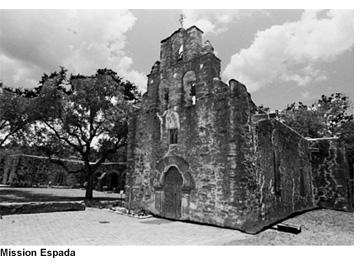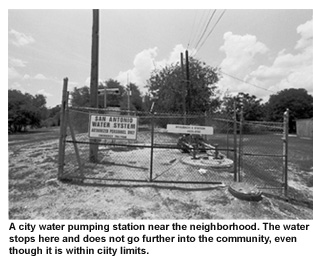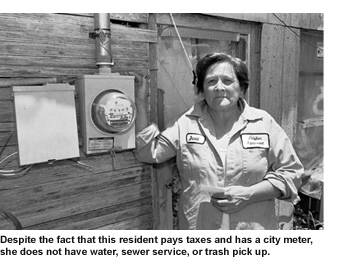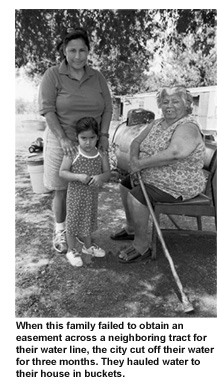Dateline Texas
Los Vecinos de las Misiones
Thousands of tourists each year flock to the historic missions of San Antonio, adding millions of dollars in revenue to the local economy. Yet few who make the trip this year will notice the housing conditions of those who live in the shadow of these popular tourist attractions—or see the outhouses and cesspools that service these areas.
Just outside the walls of the Mission Espada, within the San Antonio city limits, lies a small community with absolutely no sewer connections. Outhouses and septic tanks, many of which are leaking, fill the waste management needs of the neighborhood. Even drinking water connections are sporadic here. On one street, five dwellings share a single water meter because the residents cannot afford the $1,500 hook-up fee for their own water lines. On another road, a resident lacks an easement for his water line to go across another landowner’s property. Previously, an oral agreement with the neighboring landowner allowed this family to have running water, but after the landowner died, the San Antonio Water System cut them off. For three months, the family was forced to haul water from the homes of relatives simply to supply their daily needs. The missions themselves, with their 300-year-old aqueducts, were better served in their time.

Many of the residents live on land that has been in their families for generations. As these families grew, the land was shared among their children. Informal land division, while practical and common in long-inhabited areas, creates confusion for city planners, who are always more comfortable with neat plats and surveys. While all of the structures have electrical meters, water and wastewater services have proven more troublesome.
In 1994, a group of residents formed Los Vecinos de las Misiones to improve the housing conditions of the families outside the missions. Director Roberto Anguiano first set a goal of obtaining funding for the rehabilitation of neighboring homes–only to discover that federal funds can’t be used to improve houses that don’t have basic utilities. Organizers then turned their attention to water and wastewater service. With the help of Congressman Ciro Rodriguez and Councilwoman Toni Morehouse, the group’s efforts to call attention to the inconvenience and unhealthiness of conditions around the San Antonio missions have borne fruit. Over the last three years, the city has installed sewer mainlines and lateral lines in the neighborhoods. But getting individual houses hooked into the system has been a challenge. Approximately 85 lots still have no sewer service, though many of these residents were promised hookups three years ago.

Following a December 2001 survey, the city health department declared 36 residences in the area to be an immediate health risk. “The aquifer is at risk of contamination from the sewage pumped in the septic systems and cesspools,” a memorandum from the city’s Director of Public Health read. In addition to the risk to the immediate communities, the memo also cited a significant health risk to the entire city due to the potential for outbreaks of diseases such as hantavirus and dengue fever, which are caused by poor sanitation and contaminated living environments.
Infectious diseases are not the only risks associated with leaking septic tanks and cesspools. Some residents pile old furniture over their septic tanks so their children won’t accidentally fall in. Others walk out of their front doors right onto a dangerous—not to mention malodorous—septic cover.
One of the biggest obstacles to obtaining service is the impact fee the city assesses for water and wastewater connections. The fee is about $1,500 for water and $525 for sewer, unobtainable sums for many of the residents in these neighborhoods. The health department finding, however, provided an out. In May 2001, the city passed an ordinance that waives the fees for areas declared a significant public health risk by the city.

Property platting and code issues have proven to be a bit stickier. Texas C-Bar, a project of Texas Rural Legal Aid, helped organizer Roberto Anguiano obtain the voluntary services of two Jenkens & Gilchrist attorneys, Jeff Walsh and Jonathan Vinson, who have agreed to advise the group on the various legal obstacles that have bogged down the hookup process for many property owners. State law prohibits public utilities from serving or connecting sewer and other utility services to unlawfully divided land. If the city requires clear title, rather than partial ownership of property, it could keep many of the structures from obtaining sewer and water services. There are also prohibitions against connecting buildings that are not up to code. Ironically, denying structures that don’t meet code requirements brings the situation right back to where Roberto Anguiano started–with a push to rehabilitate dilapidated housing.

“If we can’t rehab the houses because they don’t have basic utilities, and we can’t get them basic utilities because the houses are in bad shape, we’ll go round and round in a catch-22,” Anguiano said. “There has to be someone with enough common sense and decency to decide that residents of San Antonio should not have to use outhouses and cesspools as a means of sewage disposal.”
Observer board member D’Ann Johnson is legal services coordinator for Texas C-Bar. Alan Pogue is the Observer‘s staff photographer.


